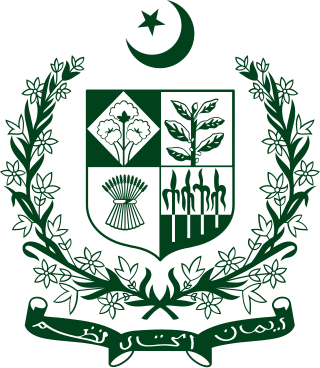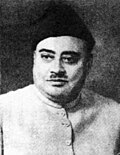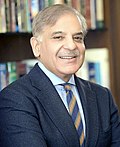Top Qs
Timeline
Chat
Perspective
List of prime ministers of Pakistan
From Wikipedia, the free encyclopedia
Remove ads
The prime minister of Pakistan[b] is the head of the Government of Pakistan.[1] The prime minister is vested with the responsibility of running the administration through his appointed federal cabinet, formulating national and foreign policies to ensure the safeguard of the interests of the nation and its people through the Council of Common Interests as well as making the decision to call nationwide general elections for the bicameral Parliament of Pakistan.[2][3][4]
- Top left: Liaquat Ali Khan was the first prime minister of Pakistan since its inception.
- Top center: Zulfikar Ali Bhutto was the first prime minister to have been democratically elected as he was in 1977.
- Top right: Benazir Bhutto was Pakistan's first and only female prime minister.
- Bottom left: Nawaz Sharif is the longest serving non-consecutive prime minister, having served a total of 9 years in his 3 incomplete terms.
- Bottom center: Imran Khan was the country's 22nd[a] prime minister and is recognized as a popular global figure.
- Bottom right: Shehbaz Sharif is the incumbent prime minister of Pakistan.
Since 1947, Pakistan has had 20 prime ministers, aside from the appointed caretaker prime ministers who were only mandated to oversee the system until the election process was finished. In Pakistan's parliamentary system, the prime minister is sworn in by the president and usually is the chairman or the president of the party or coalition that has a majority in the National Assembly– the lower house of Pakistan Parliament.
After the partition of British India on the midnight of 14/15 August 1947, Pakistan followed the British system by creating the post of prime minister based at the Prime Minister's Secretariat.[3][4] The then governor-general of Pakistan, Muhammad Ali Jinnah, took advice from the Founding Fathers of the nation and appointed Liaquat Ali Khan to establish and lead his administration on 15 August 1947.[5] Before the presidential system in 1960, seven prime ministers had served between 1947 until martial law in 1958. In 1971, the office was again revived but ceased to exist shortly.[6][7] Executive powers and authority was given to the prime minister when the full set of the Constitution of Pakistan was promulgated in 1973 but the post was ceased from its effective operations after another martial law in 1977.[8][9] After the general elections held in 1985, the office came to its existence.[6] During 1985 to 1997 executive powers were share between presidents and prime ministers due to 8th amendment to Constitution. In 1997, 13th amendment were passed and prime minister again got executive powers. Between 1988 and 1999, the office was held by Benazir Bhutto of the Pakistan People's Party and Nawaz Sharif of Pakistan Muslim League (N), each holding the office for two non-consecutive terms between 1988 and 1999: Bhutto during 1988–90 and 1993–96;[10] and Sharif during 1990–93 and 1997–99.[11][12]
After the general elections held in 2002, Zafarullah Khan Jamali was invited to form his administration as its prime minister.[13] After the Supreme Court of Pakistan's ruling to disqualify Prime Minister Yusuf Raza Gilani in 2012, the business of his administration was looked after by Raja Pervez Ashraf until the caretaker administration was setup under Mir Hazar Khan Khoso.[14][15][3][4]
Nurul Amin of the Muslim League had the shortest term, at 13 days. Yusuf Raza Gilani of the Pakistan Peoples Party had the longest consecutive term of 4 years and 86 days. At approximately 9 years and 179 days in total, Nawaz Sharif of Pakistan Muslim League (N) has been the longest-serving prime minister for a non-consecutive term.[3][16] Sharif was re-elected for a third non-consecutive term on 5 June 2013, which is a record in the history of Pakistan.[17][18] No prime minister of Pakistan has yet served their full five-year term.[19]
Remove ads
Key
Remove ads
List
Summarize
Perspective
Remove ads
List of prime ministers by length of term
- Key
- : Caretaker Prime Minister
Timeline

Caretakers
Notes
- Urdu: وزير اعظم, romanized: Wazīr ē Aʿẓam, lit. 'Grand Vizier', Urdu pronunciation: [ʋəˈziːɾˌeː ˈɑː.zəm]
- This includes both Members of Government as well as Confidence and supply
- In early October 1958, President Iskandar Ali Mirza imposed martial law, which vacated the seat of the prime minister. Three weeks later, General Ayub Khan took over as military president, ousting President Mirza through his coup d'état. He ruled as an authoritarian president until the 1968–69 Pakistan revolution. Field Marshal Ayub Khan handed over powerto General Yahya Khan in 1969, who once more imposed martial law and became an authoritarian military president, though near the end of his reign, he finally re-established the prime minister's seat by appointing Nurul Amin.
- Following the 1971 Secession of Bangladesh, Military President Yahya Khan resigned and handed over power to Zulfikar Ali Bhutto. Despite being a civilian, he ruled as chief martial law administrator and declared himself Emergency President rather than prime minister, continuing the presidential system before re-establishing the parliamentary system in 1973.
- Martial law was imposed once more following the 1977 Pakistani military coup, in which General Zia-ul-Haq declared himself as military ruler and president. The post of prime minister was therefore abolished for 8 years in his Zia's presidency until he appointed Junejo in 1985.
- Following Junejo's dismissal by Zia-ul-Haq, Zia did not appoint a replacement prime minister. Zia died in August 1988, after which Ghulam Ishaq Khan became President. The office was left vacant until Benazir's election.
- Ghulam Mustafa Jatoi was appointed as the first Caretaker Prime Minister of Pakistan to oversee elections in 1990. He formed a caretaker administration and served the required interim period of exactly 3 months.
- Moeenuddin Ahmad Qureshi was appointed as the Caretaker Prime Minister of Pakistan to oversee elections in 1993. He formed a caretaker administration and served the required interim period of around 3 months.
- Malik Meraj Khalid was appointed as the Caretaker Prime Minister of Pakistan to oversee elections in early 1997. He served the required interim period of around 3 months.
- Military General Pervez Musharraf overthrew Sharif’s government in the 1999 Pakistani coup d'état and declared himself Chief Executive before declaring himself President of Pakistan in 2001. Despite general elections in 2002, Musharraf still remained in power, with Zafarullah Khan Jamali, Shujaat Hussain and Shaukat Aziz’s tenures being heavily influenced by Musharraf who remained President until 2008.
Remove ads
External links
- "Prime Ministers". National Assembly of Pakistan. Retrieved 1 July 2012.
- "Pakistan". Encyclopædia Britannica. Retrieved 1 July 2012.
References
Wikiwand - on
Seamless Wikipedia browsing. On steroids.
Remove ads


























